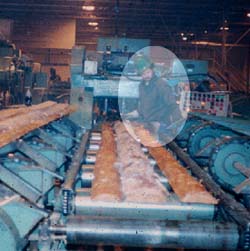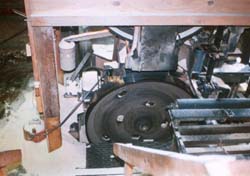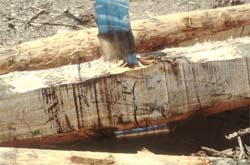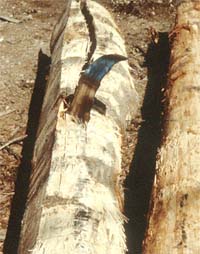
|
|
| >> Log Breakdown, Related Machinery and Facilities |
| Saws >
Band Saws |
Band saws use thin, flexible, continuous steel strips with cutting teeth on one edge. The blade runs on two pulleys, driver and idler, and through a work table where stock is fed manually.
Operator Involvement
The operator is required to hand feed and manipulate the stock against the blade to saw along a predetermined line. He/she also must keep the stock flat on the work table and exert the proper cutting pressure. |
|
|
|
| Horizontal Band Saws |

|
|
Hazards/Solutions:
The most common hazard is contact with the blade. The operator's hands may come close to the blade during cutting, and band saws cannot be completely guarded. Also, logs can kick back and strike the operator.
- Do not operate band head saws at speeds in excess of those recommended by the manufacturer. 1910.265(e)(2)(i)(a)
- Thoroughly inspect band head saws for cracks, splits, broken teeth, and other defects. Do not use a
band saw with a crack greater than one-tenth the width of the saw until width of saw is reduced to eliminate crack, until the cracked section is removed, or crack development is stopped. 1910.265(e)(2)(i)(b)
- Employees must be alerted and warned before starting band head saws. Measures must be taken to insure that all persons are in the clear. 1910.265(e)(2)(i)(c)
- Inspect band head saw wheels monthly. Thoroughly examine hubs, spokes, rims, bolts, and rivets during such inspections. Do not use wheels with loose or damaged hubs, rim cracks, or loose spokes. 1910.265(e)(2)(ii)(b)
|
|

Worker is too close to unguarded infeed
rolls, chains, and saws.
|
- Band wheels need to be completely encased or guarded, except for a portion of the upper wheel immediately around the point where the blade leaves the wheel, to permit operator to observe movement of equipment. Necessary ventilating and observation ports may be permitted. Substantial doors or gates are allowed for repair, lubrication, and saw changes; such doors or gates must be closed securely during operation. Band head rigs must be equipped with a saw catcher or guard.
1910.265(e)(2)(ii)(c)
|
|

Band saw wheel
|
- The manufacturer's recommended maximum speed must be stamped in plainly legible figures on some portion of the
band saw wheel. The wheel must not be run at a peripheral speed in excess of that recommended by the manufacturer. 1910.265(e)(2)(ii)(a)
|
|

Infeed chain conveyors (left to right) to infeed roller conveyor to horizontal band saw
|

Band saw in log
|
|

Band saw in log
|
|

|
|
|
| Home
| Log Handling
| Log Breakdown
| Dry
Kilns
| Lumber Storage
|
| Plant-Wide Hazards
| Definitions
| Additional
References
| User
Guide
| Credits
|
|
|
|
